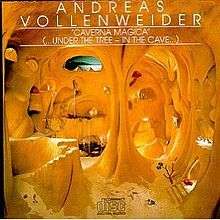Caverna Magica
Caverna Magica is the second studio album by new-age artist Andreas Vollenweider, released in 1983. It is almost entirely instrumental. It was the direct followup to Vollenweider's breakthrough album, Behind the Gardens.
| Caverna Magica | ||||
|---|---|---|---|---|
 | ||||
| Studio album by | ||||
| Released | 1983 | |||
| Recorded | May - November 1982 | |||
| Genre | New-age, space music[1] | |||
| Length | 33:30 | |||
| Label | Columbia | |||
| Producer | Andreas Vollenweider | |||
| Andreas Vollenweider chronology | ||||
| ||||
The album opens with the sound of a man and woman walking and talking in an unknown language (some of the words - notably in Spanish - can be discerned when the track is played backwards) and then stumbling into an echoing cave and reacting with awe. The sound of dripping water in the cave turns into the rhythm of the music that fades in at this point.
While the album originally stood on its own, in 1990 it and the preceding and subsequent albums (Behind the Gardens - Behind the Wall - Under the Tree and White Winds) were re-released as a two-CD set entitled "Trilogy," suggesting they collectively constituted a single musical entity.
The full titles of the first two albums lend credence to the suggestion that the three albums are thematically connected. The full title of the first album is "Behind the Gardens—Behind the Wall—Under the Tree..." The ellipsis at the end suggests a continuation. The full title of the next album is "Caverna Magica (...Under the Tree—In the Cave...)" The first ellipsis, followed by the repetition of "Under the Tree" from the first album title, clearly indicates a continuation. The second ellipsis suggests another continuation, which would turn out to be "White Winds (Seeker's Journey)." The last track on the White Winds album is entitled "Trilogy (At The White Magic Gardens) & The White Winds".
The title of the first album "is like giving someone directions: "You will find us behind The Garden, behind The Wall, under The Tree...", Vollenweider is quoted as saying on his official web site, https://web.archive.org/web/20051105034423/http://www.vollenweider.com/.[2]
The title of the second album apparently indicates a continuation of those directions: Under the tree you'll find a magic cavern. This magic cavern could be a metaphor for the recording site. This is borne out by the rest of the Vollenweider quote: "Recording this album we worked completely cut off from the world, in the cellars of the Sinus Studios in Bern (capital of Vollenweider's native Switzerland), which are more than 300 years old. In the shelter of this creative "womb", it was easy to lose track of time and space."
Sinus, where all three albums were recorded, "was a small, underground studio," stated an article in the April 2003 edition of Mojo magazine, quoted at https://web.archive.org/web/20070128001659/http://www.higgs1.demon.co.uk/barritt/mojo.htm. "It was entered by wooden shutters in the pavement above, which gave the impression of entering a crypt."[3]
The names of some tracks on the album ("Mandragora," "Belladonna," and "Geastrum Coronatum") refer to plants and fungi that have medicinal, poisonous and hallucinogenic properties (Mandragora, Atropa belladonna and Geastrum coronatum, respectively).
They are also the sort of plants one might associate with Sinus Studios, which by Vollenweider's time there already was associated with the Swiss psychedelia scene and Swiss rock. In 1972 it had been the recording site of the album "Seven Up," a collaboration between space rock band Ash Ra Tempel and drug-culture figure Timothy Leary.[4]
Any relationship between Caverna Magica track titles and Sinus Studios' history could be entirely coincidental. Vollenweider's official site quotes him as saying the album "was truly like an expedition into the deep realm of this music. The comparison with cave explorers perfectly describes our experience: beyond every corner, in every new corridor, we found unknown spaces. For us, it was as if nobody before us had ever set foot in this territory - an indescribable feeling!"[5]
Track listing
All music by Andreas Vollenweider.
| No. | Title | Length |
|---|---|---|
| 1. | "Caverna Magica" | 3:52 |
| 2. | "Mandragora" | 3:03 |
| 3. | "Lunar Pond" | 2:18 |
| 4. | "Schajah Saretosh" | 3:17 |
| 5. | "Sena Stanjéna?" | 2:28 |
| 6. | "Belladonna" | 5:21 |
| 7. | "Angóh!" | 2:45 |
| 8. | "Huiziopochtli" | 5:06 |
| 9. | "Con Chiglia" | 2:49 |
| 10. | "Geastrum Coronatum" | 1:43 |
| 11. | "La Paix Verde" | 0:48 |
Personnel
- Andreas Vollenweider - Vocals, Harp, Keyboards, Guzheng, Flute
- Erdal Kızılçay - Keyboards, Oud
- Walter Keiser - Drums
- Andi Pupato - Percussion
- Roger Bonnot- Sound effects
- Corin Curschellas - Voices
- Darryl Pitt - Photography
- David Alan Kogut - Art Direction
References
- Allmusic review
- Behind the Gardens Archived 2011-05-15 at the Wayback Machine
- "The Making of Seven Up". Mojo. April 2003. Archived from the original on 2007-01-28.
- Mojo. April 2003. Missing or empty
|title=(help)The Making of Seven Up Archived January 28, 2007, at the Wayback Machine - "Archived copy". Archived from the original on 2006-10-20. Retrieved 2009-05-08.CS1 maint: archived copy as title (link)